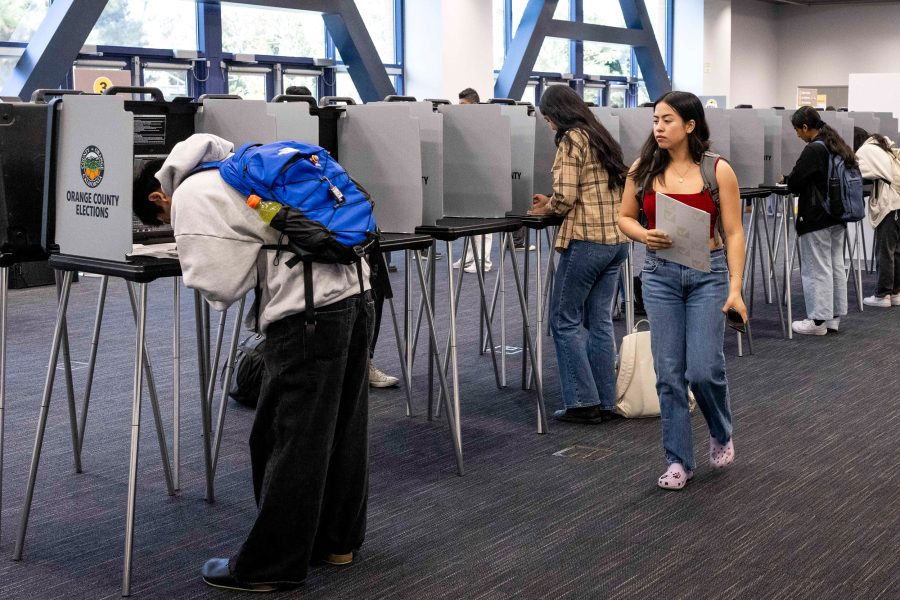Despite Climate Concerns, Young Voter Turnout Slumped and Its Support Split Between the Parties
For 19-year-old Carson Carpenter, voting for Donald Trump was a “no-brainer.”
Carpenter, who grew up in Prescott, Arizona, and was president of Arizona State University’s College Republicans until this week, said he was mainly influenced by concerns about the economy, particularly affordability. He also strongly believes in environmental protection, and he feels that progress on the environment will continue under Trump.
“I think that people that say Trump is bad for the environment, they would be totally mistaken,” Carpenter said.
As early exit polling comes out, it appears that young voters—often expected to reliably support Democratic candidates—did not vote as a monolith. Although Kamala Harris still took the majority of the youth vote, her margin of support from young voters, 6 points, was much smaller than Biden’s 25 point lead in 2020, and young men—unlike in 2020—broke in favor of Trump.
Explore the latest news about what’s at stake for the climate during this election season.
According to data from AP VoteCast analyzed by the Center for Information and Research on Civic Learning (CIRCLE) at Tufts University, young women aged 18-29 chose Harris over Trump by an 18-point-margin, but young men chose Trump by 14 points. For comparison, in 2020, young women chose Joe Biden by 32-point-margin and young men also preferred Biden, by 15 points. Results also varied by race, with young white voters preferring Trump, while young Black, Latino and Asian voters strongly favored Harris.
Although Harris’ campaign spurred some initial enthusiasm amongst young voters, disillusionment with the Democratic party persisted. Early exit polling found that national turnout among young voters this year was lower than in 2020, although in the key battleground states of Georgia, Michigan, Nevada, North Carolina, Pennsylvania and Wisconsin, turnout was somewhat stronger, close to 2020 levels. CIRCLE also found that youth voter registration trailed 2020 levels in most states.
Alice Siu, associate director of the Deliberative Democracy Lab at Stanford University, said that young voters’ opinions were more diverse than may have been expected. The lab brought together a nationally representative sample of first-time voters this summer to discuss key election issues, including the environment,
“I think sometimes we talk about the youth vote as one bloc, when it’s not really the case,” she said.
Climate Didn’t Necessarily Move Young Voters to Harris
Researchers have suggested that climate voters helped Joe Biden get elected in 2020, and that climate change was a top factor motivating voters under 45 for Biden who previously voted third-party or not at all. Young voters also consistently rank climate change as an important issue, and in the lead up to the election some experts suggested that young climate voters could tip the race in favor of Harris.
Jasmine Gil, associate senior director for Hip Hop Caucus’ Think 100%, said the organization, a nonpartisan nonprofit that aims to mobilize young BIPOC voters on issues like racial and climate justice, conducted outreach to thousands of young voters in Pennsylvania, Michigan, Wisconsin, Georgia, North Carolina, Louisiana, Texas, and Ohio. Gil said that she saw strong enthusiasm from young voters on climate and environmental justice, and the connections of the devastation from Hurricanes Helene and Milton to the broader climate crisis resonated with young voters.
Climate change was the issue where Harris had the biggest lead on trust from voters over Trump, and 82 percent of young voters who reported climate change was their top issue voted for Harris.
But some young voters who expressed interest in climate or the environment came to a different conclusion about the best path forward.
“I think for true environmental sustainability, we saw a huge advancement under the Trump administration,” Carpenter said.
Carpenter felt that electric vehicle infrastructure blossomed during the first Trump administration, and that the Democratic agenda sacrificed economic stability for environmental progress.
Public and private non-residential electric vehicle charging ports have grown nationally over the past decade and a half, more than doubling between 2015 and 2020, although Trump was very critical of EVs during his first term and has promised to undo current policies that support domestic production of EVs.
“In this next four years of Trump I think we’ll still see the same amount of progression, but we’re going to see a more privatized approach towards the climate issue,” Carpenter said.
“We make the assumption that all young people are very concerned about climate, and perhaps would do anything they could to combat climate change.”
— Alice Siu, Deliberative Democracy Lab at Stanford
Many environmental groups, though already endorsing Harris, continuously called on her campaign to make climate change more central to its platform. But despite the Biden-Harris administration’s historic investments in the clean energy transition—including job creation, provisions to lower costs and private sector incentives that poll well across party lines—the campaign shied away from talking about climate action.
“Climate is one of the areas where Harris had the strongest advantage against Trump,” said Stevie O’Hanlon, the Sunrise Movement’s communications director. “I think the campaign missed opportunities to really capitalize on that.”
A Deliberative Democracy Lab poll that included small group discussions and expert panels to track how dialogue influenced voters’ opinions found that young people were enthusiastic about climate action and measures like preventing drilling in the Arctic wilderness. But other proposals—like eliminating the sale of gas and diesel powered cars and trucks—faced some resistance within the sample, Siu said.
“We make the assumption that all young people are very concerned about climate, and perhaps would do anything they could to combat climate change,” Siu said. “And what we found actually was that even though the majority of young people were concerned about climate, there was a limit.”
Daniel Milani, a 24-year-old in Chester County, Pennsylvania, said his top reasons for supporting Trump were his platforms on the economy and abortion. Milani said he thinks that measures in favor of clean water, clean air and reducing pollution are “critical,” but said he wouldn’t vote for a pro-choice candidate just to support environmental action.
“I’m not all the time against environmental issues,” Milani said. “I think that, unfortunately, the wrong party is for them.”
Milani said he gets most of his news from YouTubers and named some right-wing content creators like Tim Pool and the Daily Wire’s Michael Knowles, as well as a Twitch streamer called Atrioc. He also said he grew up more concerned about environmental issues than he is now. He doesn’t have enough information to say whether or not human activities are the predominant factor causing global warming, he said.
“Unfortunately, I wonder how much of it is true,” Milani said of concerns about the environment and climate change. “I think it’s obvious that the earth is warming…I understand that if the earth continues to warm, sea levels may rise, storms may get more dangerous, but I think I fail to see the escape route from this that’s worth it in context with everything else that I see going on.”
Kiersten Hackman, an 18-year-old in North Carolina who worked on voter mobilization in support of Harris with a group called Rally NC, voiced personal frustration with messaging that underestimates the range of young people’s opinions about climate change.
“There has been a lot of rhetoric around, ‘Gen Z is going to save us from the climate crisis, the youth are mobilized against the climate crisis,’ and it’s really not as true as I think some people think,” Hackman said.
Overemphasizing young people’s commitment to confronting climate change has been used by politicians as an excuse to put off climate action themselves, she added.
“We need to stop with these moralizing frameworks that believe Gen Z is superior in some capacity to previous generations,” she said. “By doing this we not only keep ourselves deliberately ignorant through faulty generalizations, but we also break down any chances of cross-generational alliances, which are needed to address an issue as intersectional as the climate crisis.”
Economic Dissatisfaction
Carpenter’s choice to vote for Trump ultimately seemed to have been fortified by a belief that it would alleviate financial concerns for himself and his community.
“With the people that are closest around me saying they can’t afford groceries, they can’t afford housing, they can’t afford the daily commodities that they need to have a thriving life…that really drove me to vote for President Trump,” he said.
Ariela Lara, an 18-year-old first time voter from California who spent the last five days before the election knocking on doors with the Sunrise Movement in Arizona, trying to turn out voters for Harris, encountered similar feelings of dissatisfaction from Trump supporters and people who were undecided or felt unmotivated to vote. Many felt that their economic needs were not being met or their government was not representing their concerns.

Lara was sympathetic to these feelings—in many ways, they mirrored her own.
“Voters were so unsure of whether or not they wanted to vote at all, and they felt so disheartened about how current democracy, current systems, were not working for them, were not set up for them, and I resonated with a lot of that,” Lara said. “We are on the same page on a lot of things. I want a government that works for me. I want policies that are going to benefit my community, my neighborhood, [and] my family.”
Lara echoed criticisms that Trump’s policies pose disastrous consequences for climate mitigation and human rights, and his populist rhetoric conflicts with his close ties to billionaires and corporate interests. But she and others on the left also criticized the Democratic party’s failure to show up for working class voters.
At a Sunrise Movement virtual meeting on Nov. 6 that drew 1,600 attendees from across the country, the group outlined a plan to mobilize more young people and partner with labor unions over the next four years in an effort to “end the reign of fossil fuel elites, invest in Black, brown and working class communities, and create millions of good union jobs.” It plans to use tactics like mass disruption and strikes to pressure the federal government to invest in a transition to clean energy that prioritizes access to jobs.
Sunrise is interested in reaching out to voters who may have sat out this election or voted for Trump based on economic concerns and feelings of being left behind by traditional politics, which are mirrored on the left, particularly among working class and middle class voters. Some activists and political organizers argue that climate-focused candidates could garner more support by emphasizing environmental policies that would benefit working class voters by prioritizing union jobs, disaster mitigation and efforts to lower energy bills.
“As much as the Trump administration wants us to stay divided, we are going to fight for our neighbors, our peers,” Lara said. “I’m fighting for those people, no matter what our beliefs, where we come from…we need to fight for each other in these moments.”
About This Story
Perhaps you noticed: This story, like all the news we publish, is free to read. That’s because Inside Climate News is a 501c3 nonprofit organization. We do not charge a subscription fee, lock our news behind a paywall, or clutter our website with ads. We make our news on climate and the environment freely available to you and anyone who wants it.
That’s not all. We also share our news for free with scores of other media organizations around the country. Many of them can’t afford to do environmental journalism of their own. We’ve built bureaus from coast to coast to report local stories, collaborate with local newsrooms and co-publish articles so that this vital work is shared as widely as possible.
Two of us launched ICN in 2007. Six years later we earned a Pulitzer Prize for National Reporting, and now we run the oldest and largest dedicated climate newsroom in the nation. We tell the story in all its complexity. We hold polluters accountable. We expose environmental injustice. We debunk misinformation. We scrutinize solutions and inspire action.
Donations from readers like you fund every aspect of what we do. If you don’t already, will you support our ongoing work, our reporting on the biggest crisis facing our planet, and help us reach even more readers in more places?
Please take a moment to make a tax-deductible donation. Every one of them makes a difference.
Thank you,
David Sassoon
Founder and Publisher
Vernon Loeb
Executive Editor
Share this article
- Republish
Disclaimer: The copyright of this article belongs to the original author. Reposting this article is solely for the purpose of information dissemination and does not constitute any investment advice. If there is any infringement, please contact us immediately. We will make corrections or deletions as necessary. Thank you.
Title:Despite Climate Concerns, Young Voter Turnout Slumped and Its Support Split Between the Parties
Url:https://www.investsfocus.com







